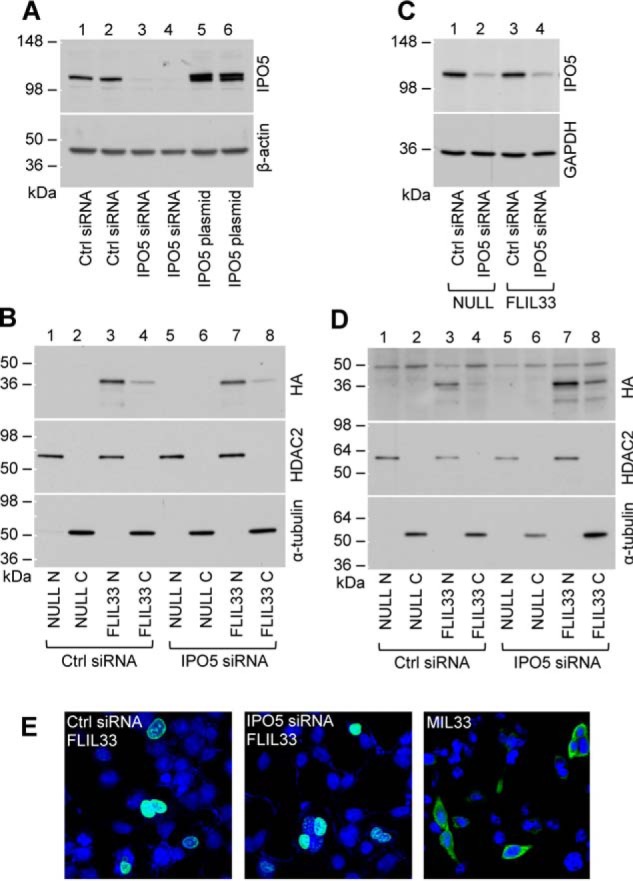Figure 3.

Attenuation of IPO5 levels with siRNA does not prevent nuclear localization of FLIL33. A, transfection of HEK293T cells with non-targeting siRNA (Ctrl) does not, whereas IPO5-specific siRNA does attenuate the basal levels of IPO5. For comparison, overexpression IPO5 using electroporation of an IPO5-encoding plasmid is also shown. The membranes were stripped and redeveloped for β-actin. B, overexpressed FLIL33HA detected with anti-HA antibody is predominantly intranuclear in both non-targeting siRNA-transfected (Ctrl) and IPO5-targeting siRNA-transfected HEK293T cells. Electroporations with a non-coding plasmid (NULL) were used as controls. Nuclear fractions are labeled with N, and cytoplasmic fractions are labeled with C. The membranes were stripped of antibodies and redeveloped for nuclear and cytoplasmic markers, HDAC2 and α-tubulin, respectively, as indicated. C, transfection of primary NHLF with non-targeting siRNA (Ctrl) does not, whereas IPO5-specific siRNA does, attenuate the basal levels of IPO5. Such attenuation is not affected by the subsequent FLIL33HA overexpression compared with electroporation with a non-coding plasmid (NULL). D, overexpressed FLIL33HA detected with anti-HA antibody is predominantly intranuclear in both non-targeting siRNA-transfected (Ctrl) and IPO5-targeting siRNA-transfected NHLF. Electroporations with a non-coding plasmid (NULL) were used as controls. Nuclear fractions are labeled with N, and cytoplasmic fractions are labeled with C. The membranes were stripped of anti-HA antibodies and redeveloped for nuclear and cytoplasmic markers, HDAC2 and α-tubulin, respectively, as indicated. E, immunofluorescent staining of cultured HEK293T cells for the HA tag (green) after electroporation with indicated siRNAs and then FLIL33HA demonstrates that FLIL33 remains intranuclear without (left panel) or with (middle panel) IPO5 attenuation. For comparison, cells similarly electroporated with MIL33HA express mature IL-33 in the cytoplasm (right panel). Nuclei were stained with DAPI (blue). The experiments in HEK293T cells were performed twice, and in NHLF, the experiments were performed in cultures from two different donors on two separate occasions, with consistent results.
